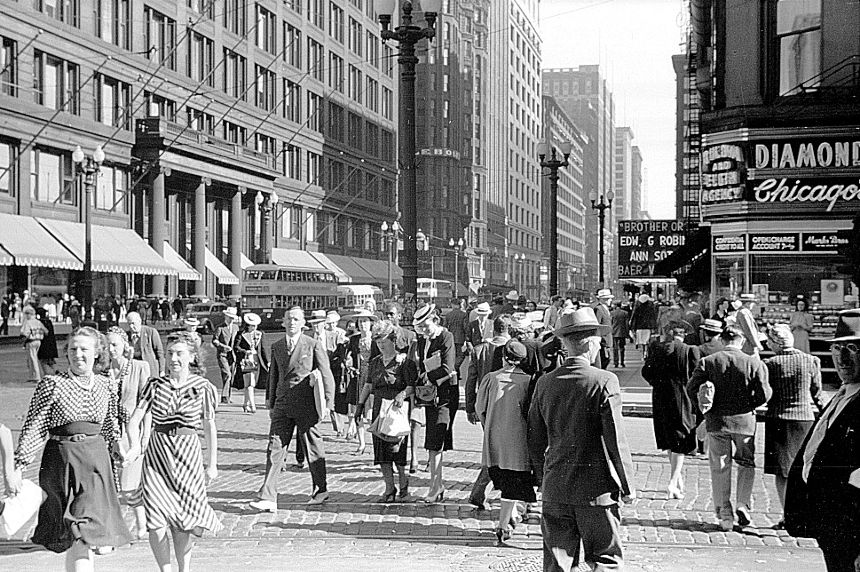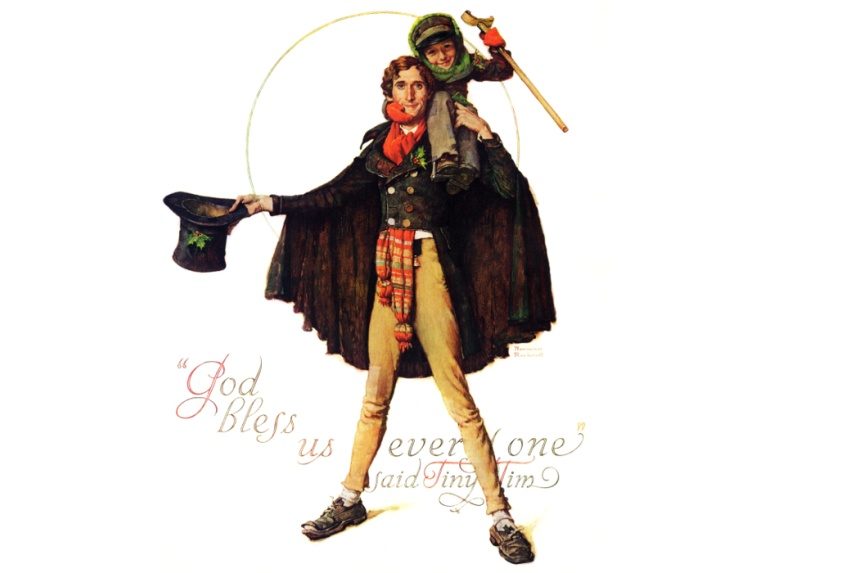I love Christmas.
No “Bah! Humbug!” for me.
But some have been more merry than others.
I’m 94, so I remember lots of Christmases. The Christmas of 1944 was the one in which the merry was strained through a kind of holiday sieve. My father had suffered a heart attack the previous month. He had survived but was still bedridden, and doctors thought he might never work again. So I’d dropped out of the Medill School of Journalism at Northwestern University and, the following Monday, headed for the Chicago Daily News Building in hopes of getting a job as a copygirl. I did.
And I found myself, a former journalism major, in the heart — the city room of the Chicago Daily News — of one of the world’s great newspapers. True, I was a “gofer” — summoned by cries of “Copy!” — and I sharpened pencils and filled glue pots and got clips from the library. I noticed as I went about my errands the canisters set out about the room — collection points for donations to the copy boys. (I was the first girl so it had probably not yet changed to “copy kids.”)
Come Friday, as he was about to leave for the long Christmas weekend, the chief of the copy kids, Jack Gullickson, emptied the canisters and, then, went to each of the copy boys, handing him a small manila envelope. When he came over to me to give me my salary check ($15 a week, minus the Monday I’d not worked), he also held one out to me. Surprised to the point of stunned, I said that I’d only been there four days, to which he said it was only half a share, but they wanted me to have it. To this day I’m not sure which meant the most: that they thought to include me or the $3.50 in the envelope. The former was certainly in the Christmas spirit I loved; the latter meant I could buy a Christmas gift for my father and my mother, which I would not have been able to do otherwise as my salary check had to go into the family coffers, drained as they were.
And so it was that I encountered Clement Moore’s A Visit from St. Nicholas on my way home.

I got off the bus at the corner of State and Randolph Streets to go to Marshall Field & Co. to buy their gifts (a tie for Daddy and a pair of silk stockings for Mother) instead of going on to Michigan Avenue and the entrance to the underground terminal for my commuter train. As I did so, I noticed the Marshall Field & Co. corner display window was not filled with mannequins stiffly posed in the latest fashion but a scene straight out of the Clement Moore poem. And in case you weren’t sure what you were looking at, it included a placard with the lines:
‘Twas the night before Christmas, when all through the house
Not a creature was stirring, not even a mouse;
The stockings were hung by the chimney with care
In hopes that St. Nicholas soon would be there;
Entranced, I detoured to the main entrance, passing the State Street windows with more scenes and verses.
As expected, the window at the corner of State and Washington Streets illustrated the ending.
He sprang to his sleigh, to his team gave a whistle,
And away they all flew like the down of a thistle,
But I heard him exclaim, ere he drove out of sight,
“Happy Christmas to all, and to all a good night.”
The special Christmas windows would appear the following year, and for several years to come. I remember, like all Chicagoans, the year Marshall Field & Co. announced the windows would not be part of Chicago’s Christmas that year.
Talk about protest! Outcry! To the battlements!
But Field’s held firm, issuing a statement that boiled down to if they didn’t stop then, when would they? Could they?
To which I say today as so many did then: Why stop?
Christmas is tradition. A veritable fruitcake, if you will, made up not of dried fruit and nuts but the customs and events, especially those with family, that make it so special. Like the Christmas tree.
Ours was usually a little over my father’s height (5’8”). Picking it out was a family event. On the given day we went to a tree lot, then went up and down the rows in search of the perfect tree. When we thought we had it, my father would hold it upright and my mother and I moved away to view it from a distance as he slowly turned it, exposing any broken branches or unsightly spaces. Full and wide. Nothing skinny for us.
We had multiple strings of lights, as I wasn’t the only one big on Christmas. For years, it was the red, yellow, blue, green lights — what I today call the Technicolor lights — but one year my mother decided she wanted to go to all blue. And it was blue. Blue. Technicolor lights made their return the following year, but as I look back on it my mother was years ahead of Elvis Presley and his “A Blue Christmas.”
Whatever the color of the lights, if one bulb burned out the whole string of lights — some 12 to 18 of them — went out. You had to take a new bulb and screw it into every light socket to find the burned out bulb (usually the last one or two). Anyone of a certain age will remember the feeling of “Oh no!” when a light went out. And the sense of gratitude to the inventor who fixed that. It may not rank up there with the discovery of fire and invention of the wheel, but it was much appreciated and made Christmas all the merrier.
The ornaments were carefully removed from the cartons into which they’d been packed, the ones from my father’s family seemingly old enough to have been held at one time by his small child’s hand as he placed it on the tree. And not a star on top finishing off the lone green spindle, but a slender, shiny glass finial the color of silver.
The family customs of Christmas made the World War II years all the more painful. Beyond the sacrifices at home and dangers to the guys overseas, our Christmases were not as they had always been. Irving Berlin’s “White Christmas” — most notably, Bing Crosby’s recording — was released the summer of 1942 and helped create a new tradition. But another, less well known song was released about that time, which got a lot of playing time on the radio and still moves me: “I’ll Be Home for Christmas.”
I’ll be home for Christmas
You can plan on me
Please have snow and mistletoe
And presents by the tree.
Almost an anthem to the separations during those World War II years and to anyone in the years since who has been away from family at Christmas time. All the more poignant this year by the separations wrought by a virus no one had heard of last year.
Christmas Eve will find me
Where the love light gleams
I’ll be home for Christmas
If only in my dreams.
It has served as musical accompaniment to a number of TV commercials. This year, the United States Postal Service. In earlier years, a beer company commercial that is a TV Christmas card — a Currier & Ives scene, a sleigh coming into sight and moving through the village. Each time I recognized it and stopped to watch, I worried that it would be the 30-second version and not the 60-second, which ends with the sleigh approaching a house on a hill, aglow with light and loved ones waiting.
Miller Beer’s 1981 Christmas commercial (Uploaded by XippVid)
And what would Christmas be without another showing of A Christmas Carol? The old 1938 version, preferably, which stars British actor Reginald Owen as Scrooge. Or more recent versions, some in Technicolor, one even a musical. Personally, I don’t think Marley’s Ghost rattles the right chains in a Technicolor musical, but to each his own.
Then there are the gingerbread men. Candy canes. Red and green M&Ms and Hershey Kisses in Christmas wrappers. Plum pudding, though few to rival Mrs. Cratchit’s in A Christmas Carol. “In half a moment Mrs. Cratchit entered: flushed, but smiling proudly: with the pudding like a speckled cannon-ball, so hard and firm, blazing half of half-a-cistern of ignited brandy, and bedight with Christmas holly stuck into the top.”
No wonder I love Christmas.
Scrooge’s “Bah! Humbug!” may have come down to us through the years, but so has Tiny Tim’s — ending A Christmas Carol and this remembrance — “God Bless Us, Everyone.”
Featured image: Norman Rockwell / SEPS
Become a Saturday Evening Post member and enjoy unlimited access. Subscribe now




Comments
What a beautiful feature. You have the ability to convey the feeling of ‘being there’ along with you in your memories. I’m sorry your father had a heart attack in November 1944 but was glad, bitter sweetly, that it led to your job at the Chicago Daily News. The right gal in the right place, at the right time, right?
That’s funny how your mom decided on ‘the blue light special’ for the Christmas tree lights that year. I agree she was definitely ahead of the curve on that one. I’m going to listen to the Elvis song; haven’t heard IT in a long time. I can relate to all the lights going out (if one did) as a small boy and my grandfather saying “G– d— it!” Almost hard to believe that problem persisted into the jet/space age if you think about it but it did. It sure did.
Thanks for writing out the lyrics to some Christmas classics here. I’ve got them in my head now which is a good thing, especially this year. I love the 1981 Miller Beer commercial very much, so beautiful. Definitely from a very bygone era. I can’t imagine such a commercial being produced today at all unfortunately; never. Just something to create a feeling of peace and goodwill only mentioning their company name at the end.
No wonder you love Christmas, indeed. Have a safe and pleasant one Val.